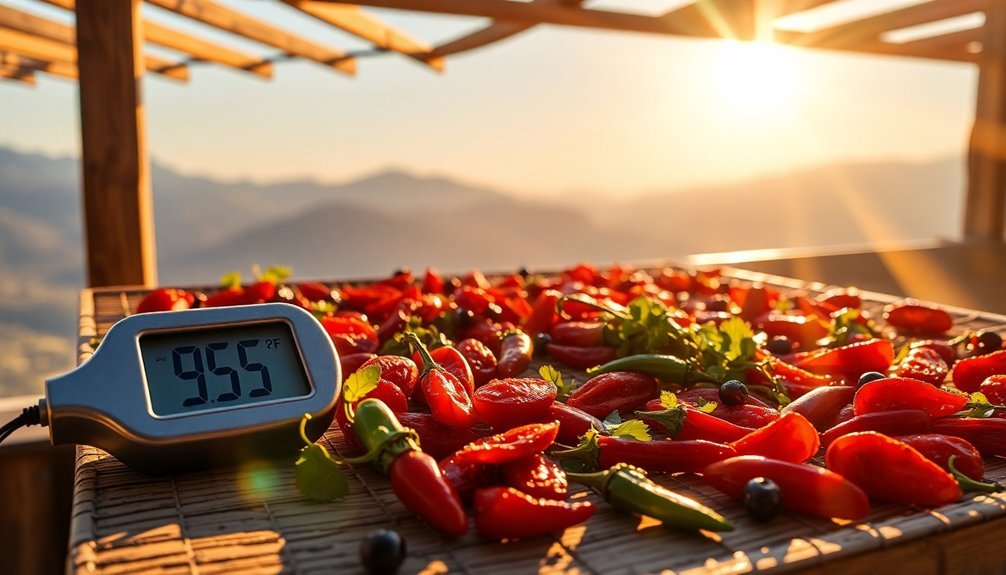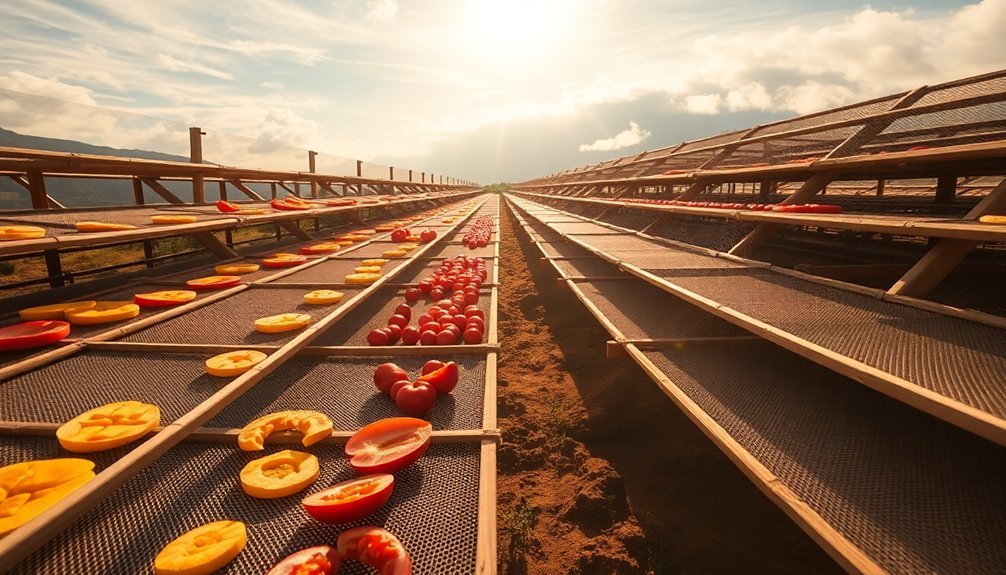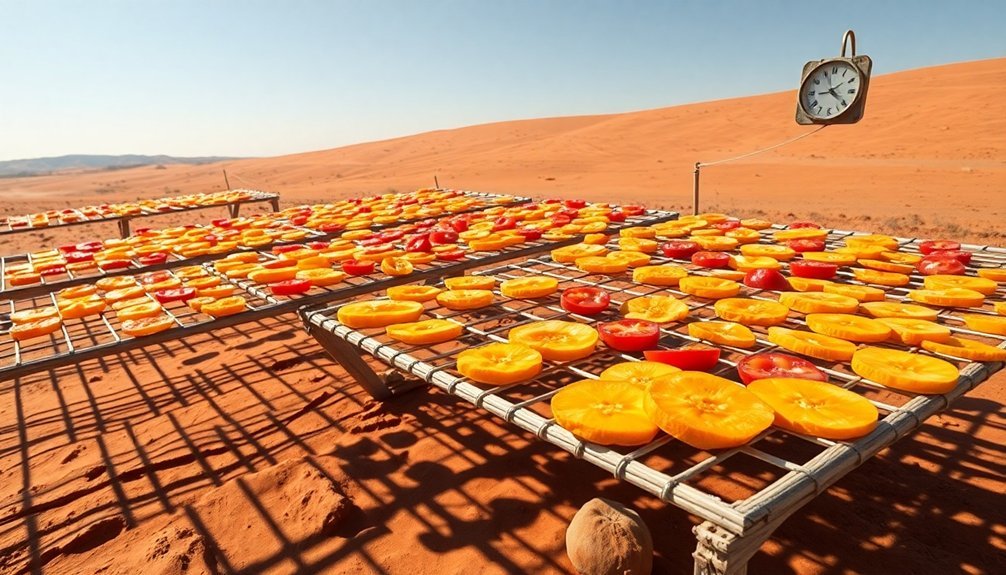Hot climates give you nature's perfect conditions for drying foods through three key factors. First, you'll benefit from intense solar heat that maintains ideal temperatures between 85°F and 140°F, which quickly removes moisture without cooking the food. Second, you'll find naturally low humidity levels under 60%, allowing faster moisture evaporation from your foods. Third, you'll get consistent air circulation that prevents stagnant moisture and reduces spoilage risk. These elements work together just like ancient preservation techniques that have kept foods fresh for thousands of years – and there's much more to discover about this time-tested method.
Heat and Solar Energy Benefits

When you're looking to dry foods naturally, heat and solar energy offer powerful benefits that make the process both effective and sustainable. The ideal temperature of 140 °F lets you dry food thoroughly without cooking it, while lower temperatures prevent case hardening, where trapped moisture can lead to mold.
You'll find that warm temperatures effectively draw out moisture, and the heat maintains enzyme activity at a level that preserves nutritional value. The optimal environment requires humidity below 60% for successful drying outcomes.
You can harness the sun's free energy to achieve these perfect drying conditions, making it an excellent choice for food preservation. Solar drying isn't just cost-effective – it's also environmentally friendly, producing no greenhouse gas emissions.
You'll notice that foods dried using solar energy often retain more nutrients compared to other methods, and you'll appreciate how this technique can enhance natural flavors, creating more intense and delicious results.
If you're in a rural area or region with limited electricity, you'll find solar drying particularly valuable since it requires minimal equipment and no power source.
The combination of proper heat and solar energy creates an efficient, sustainable way to preserve your food while maintaining its quality.
Low Humidity Drying Advantages
Low humidity conditions let you dry your foods faster by speeding up moisture movement from the food to the surrounding air.
You'll naturally prevent mold growth since the dry air reduces the chance of microbial activity during the drying process. Foods with Water Activity below 0.60 are typically safe from microbial spoilage.
Your dried foods will maintain better quality and texture because the low humidity environment guarantees even drying without case hardening or moisture reabsorption.
Faster Moisture Movement
Three key factors determine how quickly moisture moves out of food during the drying process: humidity levels, air circulation, and temperature.
You'll achieve the fastest drying results when humidity stays below 60%, as dry air can absorb more water vapor from your food. When the relative humidity is high, the air becomes saturated quickly and can't remove additional moisture.
Proper air circulation plays an essential role in speeding up the drying process. You'll want to guarantee constant air movement to carry away moist air from your food's surface. Selecting fully ripened fruits ensures optimal moisture content and drying efficiency.
Using fans or vents in your drying setup prevents case hardening and greatly reduces drying time.
Temperature control is critical for efficient moisture removal. The ideal drying temperature shouldn't exceed 140°F to avoid cooking your food.
For best results in hot climates, you should:
- Maintain temperatures between 85°F and 140°F
- Use solar driers designed with enhanced airflow
- Position your drying setup to maximize natural air circulation
Modern food dehydrators combine these factors effectively, but you can achieve similar results with well-designed solar driers that leverage hot, dry air and proper ventilation.
Natural Mold Prevention
Successful food drying depends heavily on creating conditions that naturally prevent mold growth. You'll find that hot climates create a perfect environment by maintaining low humidity levels, which allows moisture to move quickly from your food into the surrounding air. When you're drying foods, you'll want humidity below 60% RH to minimize the risk of bacterial and mold growth.
| Factor | Problem | Solution |
|---|---|---|
| Humidity | High moisture retention | Keep humidity below 60% RH |
| Air Flow | Stagnant moist air | Use fans or natural breezes |
| Temperature | Slow drying time | Maintain 140°F ideal temp |
| Protection | Contamination risks | Cover with screens/cloth |
To maximize your drying success, you'll need proper air circulation to move moisture away from the food continuously. Using fans or positioning your drying setup in natural air currents prevents the surrounding air from becoming saturated. You'll also want to maintain temperatures around 140°F to guarantee effective drying without cooking the food. Don't forget to protect your drying foods from contaminants by using screens or cheesecloth covers, which allow airflow while keeping out dust, insects, and other unwanted elements.
Better Food Preservation Quality
Building on these mold prevention practices, proper drying conditions directly impact the quality of your preserved foods. When you're working with hot climates, you'll find that low humidity environments create ideal conditions for achieving superior food preservation results. The combination of warm temperatures and dry air accelerates moisture evaporation, preventing case hardening and ensuring uniform drying throughout your food items.
To maximize your food's quality during the drying process, focus on these key elements:
- Maintain temperatures above 85°F to speed up moisture removal while keeping relative humidity below 60%
- Use elevated drying racks or screens to enhance air circulation around your food
- Protect your drying items with cheesecloth that allows proper airflow while keeping contaminants away
You'll notice better color retention and nutritional preservation when you properly control these conditions. The faster drying rates in hot climates help you achieve the ideal final moisture content, typically below 20% for fruits.
Remember to package your dried foods in moisture-proof containers immediately after they've reached the desired dryness level, as properly dried foods can quickly reabsorb moisture from humid air.
Natural Air Flow Systems

Natural air flow systems harness the power of ambient conditions to efficiently dry foods while minimizing energy use. You'll find these systems typically consist of a grain bin with a perforated floor and drying fans that create consistent air circulation throughout your food products.
When you're drying foods, the system's success relies heavily on temperature and humidity control. You'll get ideal results when temperatures stay below 140°F, preventing unwanted cooking while maximizing moisture removal. The fans actually help by adding heat through compression, raising the temperature about 0.75ºF per inch of static pressure, plus an additional 0.75ºF to 1.0ºF from the motor heat.
You'll need to maintain continuous air circulation to prevent moisture from getting trapped and causing spoilage. The moving air helps distribute heat evenly and carries away water vapor efficiently.
While you're operating the system, you'll only need to use fossil energy for the fan, making this method highly energy efficient. You'll find maintenance requirements are minimal, mainly focusing on keeping your fans in good working order and ensuring your food surfaces remain level for uniform drying.
Extended Daylight Hours
Taking advantage of extended daylight hours makes all the difference in sun-drying foods effectively. You'll find that longer sun exposure periods considerably impact drying times, with fruits needing 2-4 days and vegetables requiring 3-5 days to reach ideal dryness.
When you're working with extended daylight, you'll want to position your drying racks on south-facing slopes to maximize sun exposure throughout the day.
To make the most of extended daylight hours, you'll need to take into account these essential factors:
- Maintain temperatures between 85°F to 100°F (29°C to 38°C) during peak sunlight hours
- Keep humidity levels below 60% to prevent mold growth
- Rotate food items regularly to guarantee even drying on all sides
You can enhance the drying process by using reflective surfaces like aluminum foil or mirrors to increase sun exposure.
Remember that while extended daylight is beneficial, you'll need to monitor your foods carefully as they near completion. Once they're no longer sticky, move them to the shade to prevent over-drying and browning.
This careful timing helps maintain the ideal 15-20% moisture content that inhibits microbial growth while preserving food quality.
Traditional Desert Preservation Methods

Desert cultures have mastered food preservation methods through centuries of practice in challenging environments. You'll find their techniques remarkably effective, from the ancient ZEER pot system to modern adaptations of traditional drying methods.
The ZEER pot, which originated in Ancient Egypt around 2500 B.C., remains a practical solution for food preservation. You can create one by placing a small clay pot inside a larger one, filling the gap with damp sand, and covering it with a wet cloth. This simple setup can cool your food to as low as 4.4°C through evaporation.
You'll discover that desert conditions are ideal for drying foods, with low humidity and high temperatures accelerating the process. You can dry fruits, vegetables, and meats within a day or two using basic equipment like saw horses and corrugated metal roofing.
For nighttime cooling, you'll benefit from placing foods in shaded areas or using an ice chest that's opened at night to take advantage of radiational cooling.
When it comes to long-term storage, you can preserve foods through canning, which keeps them viable for up to five years in desert conditions. Using outdoor pantry barrels provides reliable storage for your preserved goods.
Sustainable Food Storage Solutions
When you're looking to store dried foods sustainably, you'll find that airtight stainless steel and glass containers offer zero-waste solutions that can last up to 40 times longer than conventional storage options.
You can maximize your food's shelf life without using electricity by keeping these containers in cooler spaces below 75°F, such as basements or north-facing rooms.
These energy-free storage methods not only preserve your dried foods effectively but also support environmental sustainability through their recyclable materials and minimal production waste.
Zero-Waste Storage Methods
Modern kitchens increasingly embrace zero-waste storage solutions that preserve both food and the environment. You'll find sustainable options ranging from infinitely recyclable stainless steel containers to chemical-free glass storage that keeps your food fresh without harming the planet. These alternatives eliminate single-use plastics while maintaining food quality and freshness.
For ideal zero-waste food storage, consider these essential container features:
- Air release technology that prevents spoilage by maintaining proper humidity levels
- Modular designs that combine different sizes for versatile storage options
- Breathable materials like organic cotton bags for extending produce freshness
You can maximize your zero-waste journey by choosing ceramic-coated containers for acidic foods, silicone bags for versatile storage, and beeswax wraps for items like bread and cheese.
These options aren't only environmentally conscious but also practical, offering features like dishwasher safety and leak-proof seals.
When selecting storage solutions, look for materials that are Cradle to Cradle Bronze certified, produced under fair labor practices, and made from pure, recyclable materials like platinum-grade silicone or Tritan Copolyester with removable gaskets for thorough cleaning.
Energy-Free Preservation Techniques
Building on sustainable storage practices, energy-free preservation methods offer powerful solutions for maintaining food without electricity.
You'll find that hot climates provide ideal conditions for sun-drying, where high temperatures and low humidity naturally remove moisture from foods, making them lighter and less susceptible to spoilage.
You can implement multiple preservation techniques without using any power. The Zeer pot and charcoal cooler systems use evaporative cooling to extend your food's shelf life up to 20 days, while canning creates sterile, vacuum-sealed environments that keep foods fresh for months.
When you're preserving fruits and vegetables, you'll notice that both methods are particularly effective at maintaining nutritional value.
Don't overlook fermentation and pickling, which create naturally acidic environments that prevent bacterial growth.
You're not just preserving food – you're often enhancing its nutritional profile through beneficial microorganisms. These methods work well for vegetables, meats, and dairy products.
You'll appreciate how these preservation techniques complement each other: while drying works best in hot weather, fermentation and evaporative cooling can be effective year-round, giving you a complete system for food preservation without electricity.
Long-Term Storage Benefits
Three key benefits make sustainable food storage solutions essential for long-term preservation: cost savings, environmental impact reduction, and food security.
When you store food properly in airtight, food-grade containers, you'll protect your investment while ensuring peak shelf life and nutritional value.
You'll achieve superior results by following these critical storage practices:
- Keep temperatures below 70°F and humidity low
- Use BPA-free containers or Mylar bags
- Implement a first-in, first-out rotation system
Proper storage containers, like stainless steel or glass options with lifetime warranties, provide lasting protection against heat, moisture, and pests.
You'll find that silicone bags offer a non-toxic, infinitely reusable solution that helps reduce environmental waste while maintaining food quality.
By storing newer items behind older ones and regularly inspecting for signs of spoilage, you'll maximize your food's shelf life.
Remember that canned foods stay safe indefinitely when stored below 90°F, with high-acid foods lasting 12-18 months and low-acid foods lasting 2-5 years.
Your dry goods can safely freeze but must remain in low-humidity environments to prevent moisture damage and maintain long-term viability.
Frequently Asked Questions
Can Extreme Heat Damage Nutrients During the Sun-Drying Process?
Yes, extreme heat can damage your food's nutrients during sun-drying. You'll lose vitamins C and A through oxidation, while your carotenoids break down when exposed to heat, light, and oxygen during the process.
How Do You Protect Sun-Dried Foods From Sand and Dust Storms?
You'll need to protect your sun-dried foods by covering them with cheesecloth or fine-mesh screens, storing them in enclosed solar dehydrators, and quickly moving drying racks indoors when dust storms approach.
What Indicators Show That Food Has Been Sufficiently Dried?
You'll know your food's sufficiently dried when it's leathery but pliable for fruits, brittle for vegetables, and doesn't release moisture when pressed. Use DryCards or check for condensation in sealed containers for certainty.
Why Do Some Fruits Require Pre-Treatment Before Sun Drying?
You'll need to pre-treat certain fruits to prevent browning, maintain color, and preserve nutrients. It'll also protect against oxidation, improve texture, and extend shelf life during the drying process.
How Long Can Properly Sun-Dried Foods Remain Safe for Consumption?
You'll find that properly sun-dried foods can last 6-12 months in your pantry. If you store them in the fridge, they'll keep for 1-2 years, and they'll stay safe indefinitely in your freezer.
In Summary
Hot climates give you the perfect conditions to dry your foods naturally and efficiently. You'll find that intense sunlight, low humidity, and consistent air flow work together to remove moisture quickly while preserving nutrients. You can take advantage of extended daylight hours and traditional desert preservation techniques that have worked for generations. This sustainable method lets you store food long-term without using electricity or artificial preservatives.





Leave a Reply